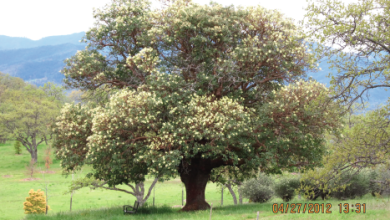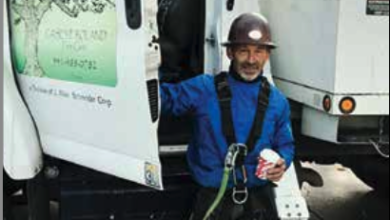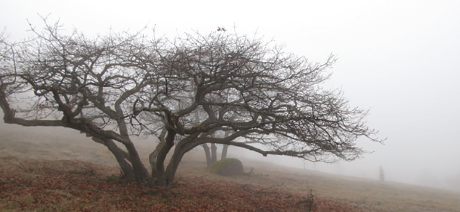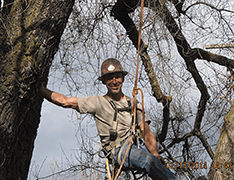Thou Shalt Not Top Thy Tree…
What is the definition of “topping” a tree? Among various circles among the arboricultural community, the term “topping” could be interpreted in a few different ways. In general, none of the examples given sound like it is a good thing to do to your tree.
If you do a Google search of: “why is it a good thing to top a tree?” Or, “why should I top my tree?”, your computer monitor will probably just sit there and stare at you like an old mule contemplating a new gate. Now, if you type in: “Why is it bad to top my tree”, and mash the enter button, your computer will vibrate around on the desk for about ten seconds before bursting into flames and melting itself down to the motherboard!
Before we can define “topping”, I think we need to identify where the top of a tree is located. Guess what? There is no standard definition that I can find for the “top” of a tree. Heck, I’ve been doing tree work most my life, and even I can’t pin it down! I think I am going to do the world a favor and come up with the definition of “The top of the tree” myself, and settle this matter once and for all.
Ready? Here goes: “The top of the tree, consisting of that portion of the tree, and that which is immediately above, and adjacent to, the middle portion of the tree, and directly opposite from, and opposed to, the bottom portion of the tree”.
Now then, that is about as vague as recipe-less goulash, isn’t it? The sad fact is, the “top” of the tree will remain definition-less for the rest of time…
So how can we define “topping” if we don’t know where the top of the tree is? For instance, if I snip off 1/4” from the very top of a 300’ redwood, would that constitute “topping”? What if I snip the same 1/4″ from a 2” tall redwood? Do you see where I am going with this?
My criteria when training apprentice arborists consists (among many things, of course) of the following questions. What are you cutting from the tree? Why are you cutting it? Where are you going to make the cut? How are you going to make the cut? And most important of all, and I can’t stress this enough, WHAT ARE THE EFFECTS OF THE CUTS YOU ARE MAKING, GOING TO HAVE ON THE TREE?
If an arborist does not know the effects of the cut, they should not be in the business until they do know, and by the same token, if they know that their cuts are going to have a negative effect on the tree, and do it anyway, they shouldn’t be in the business, period.
Topped trees are NOT safe trees. Topped trees will cost more to maintain and/or remove later. Topping your tree strips it of its dignity. Topped trees dramatically lose their landscape appraisal value. Topped trees will lower your property value. Topping trees is against many cities’ ordinances. Topping your trees will not “buy you some time”. Topping your trees is a huge waste of money. Topping your tree will shorten its lifespan. Topping your tree is a crime against nature. Topped trees can kill you!
Now for the easy part…
If you “top” a conifer, such as a Fir, Pine, Spruce, Hemlock, etc., and it doesn’t croak, this is what will probably happen: the top whorl of limbs will begin a throttle-pinned race for the sun, to see who can become the new “top dog”. This takes a few years to really get going and during that initial period after topping, the sun literally fries the tops of the now- exposed uppermost limbs, cooking the cambium layer beneath the thin bark, killing it. Flat Head Boring Beetles may start going to work on these compromised areas further weakening them while vectoring in various pathogens, including decay causing organisms. The pruning injury may remain open for quite a few years depending on species and size of the cut, providing the perfect environment for decay to start consuming the mainstem of the tree. If the new “tops” (limbs) get big enough to sustain the tree, and they usually do, they probably now have a weakened attachment point. Needless to say, climbing past that point can be harrowing. I have done it many times, it is not fun.
Now onto the broadleaved hardwood section of this article.
When an Oak, Maple, Ash, Elm, Poplar etc. is “topped”, decay starts immediately at the point of injury, and depending on the species, it tends to “run” longitudinally within the stem, and the only place for it to go is down. Below the cut, the next available growing point (dormant bud, for example) springs into action to replace the top. It is almost never alone! These sprouts are VERY weakly attached to the outside of the stem, and many fail before they can get big. The sprouts that do get big can be one of the most dangerous things in an arborists life. These new “tops” have such a compromised attachment point that they can puke at any time, especially if you are tied into them! The old timer climbers called this “scab wood” and it is a very fitting term indeed…
So why is the reaction of all trees pretty much the same when it comes to “topping”?
Because trees are survivors! When you “top” a tree, it thinks you are trying to kill it, and it goes into “DEFCON 5” survival mode. Trees do lose their tops in the wild due to wind, lightening and such, so they have had to come up with a way to survive the loss of their top. It isn’t the best way to go on living, but it gives them a shot at it. If losing their top doesn’t kill them outright, it will most certainly shorten their lifespan! When a tree loses its top, it loses some of its ability to manufacture food for itself. Severe topping kills a tree by literally starving it to death.
There are a few terms such as “crown reduction”, “de-horning”, “heading”, “drop crotching” “T/S”, “giving it a good haircut” and many more I’m sure. What they really mean would depend on the arborist preforming the work, how the arborist preforms the work, the goal of the arborist doing the work, as well as the arborists expectation of what the result of the work will cause the tree to do, down the road.
Before anyone thinks I’m some kind of ‘treema-donna” needing to fall off of my high horse, no worries. I fell off that horse a long time ago. I have topped thousands of trees in my career as a municipal arborist (journeyman line clearance tree trimmer) in my younger years. I shudder to think of some of the “hack jobs” that I did to trees back in those days. I wish I knew then, what I know now…
Improper pruning will usually be indicated by the tree going into survival mode. Proper pruning procedures (say that 10 times fast) should have little response from the tree, if any. Winter is a great time to play “spot the topped tree” around town. It really is a shame seeing some of the more recently hacked trees, I thought we all knew better! Take a picture of a recently hacked tree now, and revisit the tree in a couple of years and hold the picture up next to it. This should bring it all home for you, making it obvious why you don’t want to “top” your tree. Then tell everyone you know, you will be doing the trees a big favor!
Topping your tree is like rolling your brand new Subaru. You can get it repaired, but it will never be the same. Its title will be forever branded…




